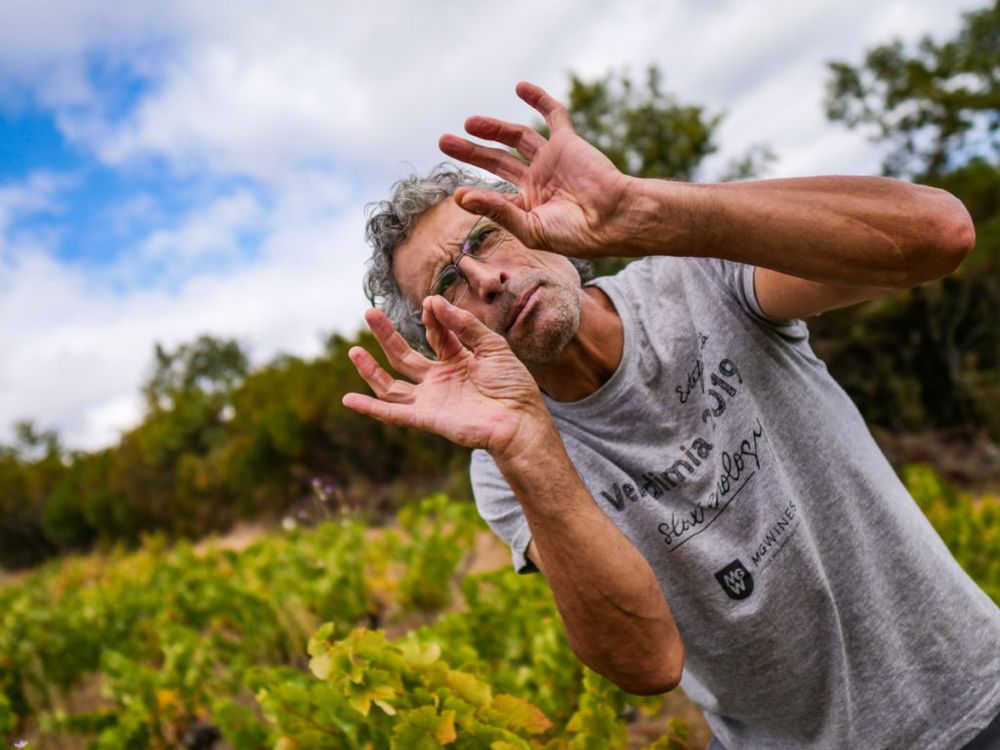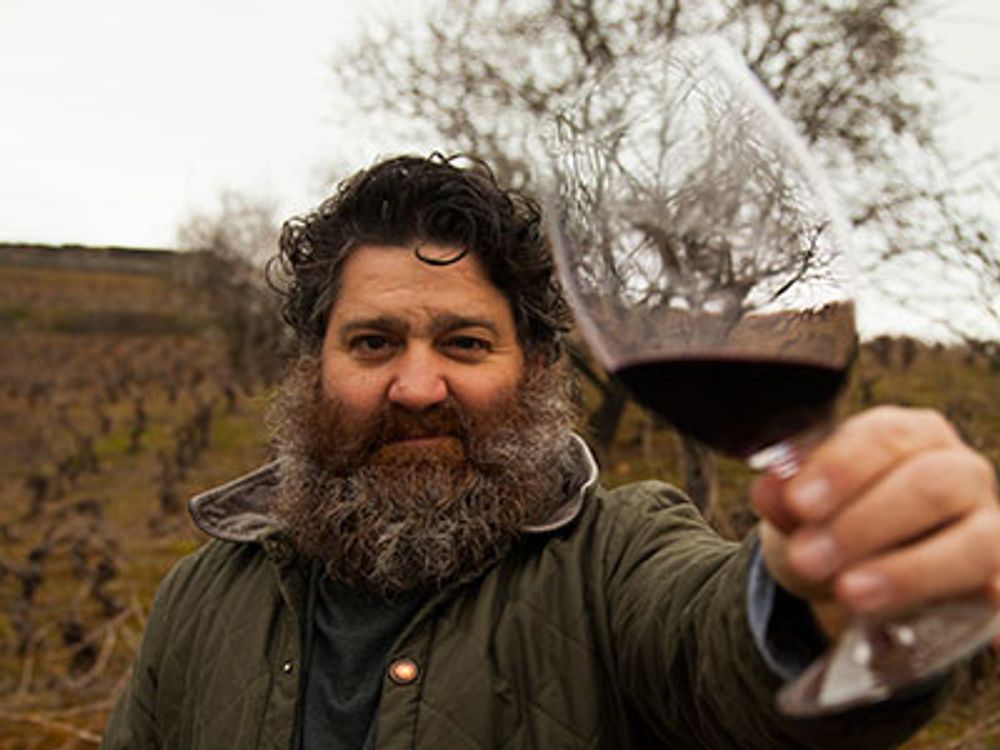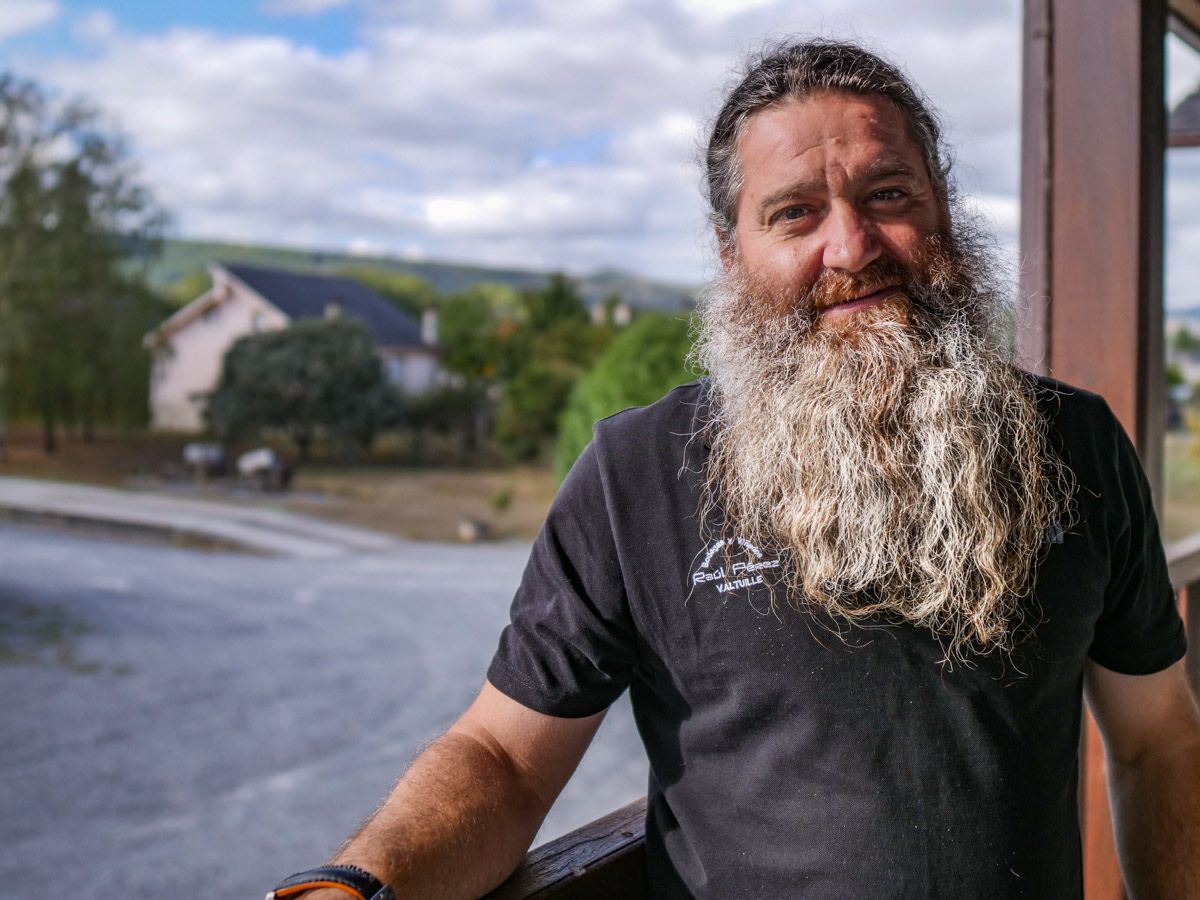Raúl Pérez is passionate about winemaking. Sorry, he is passionate about the grapes that allow him to make the wines he wants, which for him means working in Bierzo and making wines using its two key grape varieites – Godello and Mencía.
If any winemaker in Northern Spain has the wine world’s attention, the bearded Raúl Pérez does. He explores the terroirs as diverse as Galicia, Ribeira Sacra, Valdeorras and, of course, his home Bierzo.
With wide recognition from wine magazines and critics Pérez manages to keep things simple and won’t act as some of his winemakers-become-stars fellows. Other than making wines with amigos from around Spain, he produces his own wines of several labels and varieties (including some rare ones). He consults a bit — for example, been for ages with Bodeagas Estefania, supervising the line of wines called Tilenus and sourced from old vines.
Bierzo – The New Spain

Bodegas Estefania’s “passionate” vineyard manager Jose Prada
Bierzo is one of the most interesting wine regions of Spain, the New Spain, that is. Yet, it’s so small and distant from major tourist destinations (except probably the famous religious path El Camino that crosses it) that we rarely see Bierzo verticals or significant regionals tastings. A five hour bus trip from Madrid doesn’t help either.
We’ve met with Pérez at Bodegas Estefania to talk about the Bierzo’s major protagonists — Godello and Mencía — and taste some of the Tilenus wines. Thanks to his efforts and those of his winemakers like Rafael Palacios the interest to both reds and whites of Bierzo is growing. “Unfortunately the price of land is rising too; in four or five years we will have big problems finding new land to plant vines,” he says, pouring young Godello.
The region of Bierzo got its richness from the coal mining industry: abandoned mines, shut down by the government, can be found all over the region. The Romans knew Bierzo was a treasure “island”, too. Las Médulas is a breathtaking example of a well-preserved gold-mining area, and, of course, a UNESCO heritage site well worth visiting.
Pérez’s speech flows, although he occasionally slips to Spanish. “The classic wines of Bierzo have always been 12-13% alcohol, now we are getting closer to 14-14,5%. And for me it’s very important to keep the original wines, the wines that were easy to drink. The high level of alcohol is the opposite of this idea. It’s like the cocktail culture: the levels of alcohol has been going down over time. People want to be able to drink more. This is also why we have to harvest earlier these days”.
The virtues of Bierzo’s Godello

Raúl Pérez is inspired by Godello Picture: SpanishWineLover
Back from Burgundy with some barrels for his wines, Pérez is very clear about what inspires him. “Godello does resemble Chardonnay. It might have some different notes, but the sensation is alike: the density, the acidity et cetera. The similarity with Chardonnay is very noticeable in cold vintages. In warmer vintages Godello becomes quite different,” he explains.
“The beauty of Godello is it remains very drinkable after 10 years of cellaring. The variety takes bottle ageing well, even 15 years is not a problem and it feels home in Ribeira Sacra and in Valdeorras. Of course, the aromatic profile there will be different due to climatology and the soils composition. In Bierzo you will find more clays, in Ribeira Sacra, for example, there’s more schist”.
Pérez is sure that unlike Mencía the amount of old-vine Godello in Bierzo is very small. “No more than 2-3% are there Godello vines of 100-120 years old. The majority of Godello in Bierzo would be around 20 years old. There are people who are looking to expand their Godello projects, wineries like Emilio Moro. Spain in general has issues with white varieties: it’s hard to make wines with good natural acidity. With the south of the country getting hotter and hotter every year, the north is the only place for the whites.”
Bierzo’s wine face has changed significantly over the years. “Thirty five to forty years ago 65% of grapes were being sent to cooperatives. Only a third of growers bottled wine themselves,” — says the enologist. “Today 90% is bottled by small wineries here and only 10% goes to the cooperatives. There are 77 wineries in Bierzo, of these 50 are very small and everyone is making wine on their own. This balance dictates the new profile of Bierzo wines.”
Old Mencia, young wines

Raúl Pérez works with Justerini & Brooks in the UK
Tasting a young 2018 Mencia, Pérez chuckles: “We do nothing with this wine: no barrel. Its essence is youth, it must relay the grapes. The best time to drink this wine is in five or six years. Very typical for Bierzo – young wines that drink well after significant ageing.”
This is the paradox of the region. Young wines in 99% cases means young vines. In Bierzo, not that straightforward. “
“This it not squandering, we also use old vines for our top wines. There are simply no other vines here,” he says. “In fact, the price for grapes from old and young vines is the same. So the choice is clear. We work with growers who started selling us grapes twenty years ago, exactly at that moment when the winery was born. You realise now what kind of long-term relations these are.”
“Mencía wines are chameleons,” he adds, pouring one of the Tilenus single-vineyard wines, La Florida. He believes the young reds from Bierzo are very similar in their expression to the Rhone’s Syrah, but as wines reach four to 10 years old, they become more complex and subtle, coming closer in style to the Southern Burgundy. “When Bierzo wines reach the maturity of 20 years, they start to ‘sound’ like Northern Italy. In blind tastings people often confuse Bierzo with other regions and countries — depending on the vintage. Mencías 2004-2005 from 80-90-year-old vines drink well right now.”
An example of what a vineyard planted in 1902 can achieve is the single cru Pieros. Pérez pours a very young 2012: “This is a vineyard with a southern exposure, a stunning wine. The production is small, we only make 8-9 barrels.” We are exposed to a seven-year-old Mencía with the aromas of spices, ink and with a great complexity.”

Jose Prada is inspired working with the 100 plus year old vines
The cherry on the cake is a trip into the old vineyard with Bodegas Estefania’s passionate vineyard manager Jose Prada. Jose helps discover the heritage and richness Bierzo has to offer; he walks into the 117-year-old bush Mencía vineyard, pointing out the minuscule berries they give off every vintage. Interestingly, even with old vines like those, one has to stay alert about the water stress during the periods of extreme summer heat. Jose speaks about the vines and vineyards in Spanish, being very sure everyone can understand him.
His body language tells much more that his words.









































